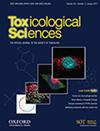Simulated burn pit smoke condensates cause sustained impact on human airway epithelial cells.
IF 3.4
3区 医学
Q2 TOXICOLOGY
引用次数: 0
Abstract
Inhalation of smoke from burn pits during military deployment is associated with several adverse pulmonary outcomes. We exposed human airway epithelial cells to smoke condensates from burn pit waste materials. Single and repeated exposure to condensates triggered unique and common responses in terms of gene expression that were sustained through the recovery phase. Source material and combustion condition influenced the outcome. Intensified response in female donor cells indicated a determining role of biological sex. The observations indicate a lasting impact of burn pit smoke exposure on epithelial gene expression, potentially contributing to disease pathogenesis.
模拟燃烧坑烟雾冷凝物对人体气道上皮细胞造成持续影响。
军事部署期间从烧伤坑吸入烟雾与几种不良肺部结局有关。我们将人类气道上皮细胞暴露于燃烧坑废物产生的烟雾凝聚物中。在基因表达方面,单次和反复暴露冷凝物引发了独特和共同的反应,这种反应持续到恢复阶段。原料和燃烧条件对结果有影响。雌性供体细胞的反应增强表明生物性别起决定性作用。观察结果表明,烧伤坑烟雾暴露对上皮基因表达的持久影响,可能有助于疾病的发病机制。
本文章由计算机程序翻译,如有差异,请以英文原文为准。
求助全文
约1分钟内获得全文
求助全文
来源期刊

Toxicological Sciences
医学-毒理学
CiteScore
7.70
自引率
7.90%
发文量
118
审稿时长
1.5 months
期刊介绍:
The mission of Toxicological Sciences, the official journal of the Society of Toxicology, is to publish a broad spectrum of impactful research in the field of toxicology.
The primary focus of Toxicological Sciences is on original research articles. The journal also provides expert insight via contemporary and systematic reviews, as well as forum articles and editorial content that addresses important topics in the field.
The scope of Toxicological Sciences is focused on a broad spectrum of impactful toxicological research that will advance the multidisciplinary field of toxicology ranging from basic research to model development and application, and decision making. Submissions will include diverse technologies and approaches including, but not limited to: bioinformatics and computational biology, biochemistry, exposure science, histopathology, mass spectrometry, molecular biology, population-based sciences, tissue and cell-based systems, and whole-animal studies. Integrative approaches that combine realistic exposure scenarios with impactful analyses that move the field forward are encouraged.
 求助内容:
求助内容: 应助结果提醒方式:
应助结果提醒方式:


